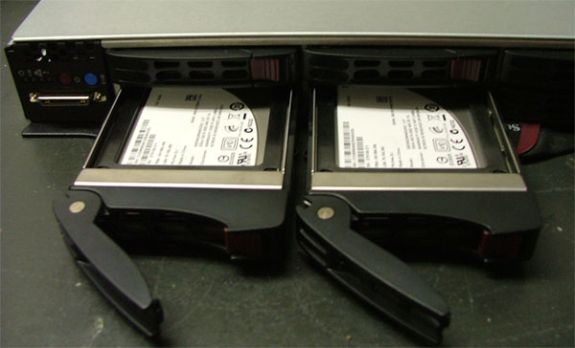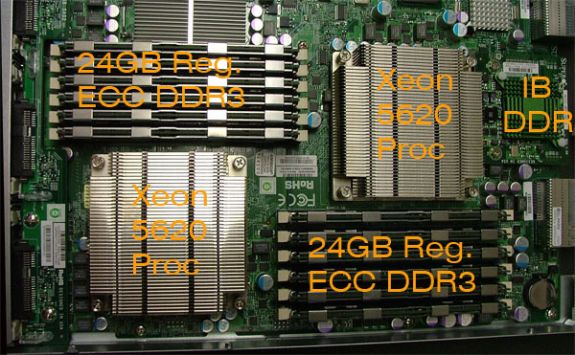ZFS - Building, Testing, and Benchmarking
by Matt Breitbach on October 5, 2010 4:33 PM EST- Posted in
- IT Computing
- Linux
- NAS
- Nexenta
- ZFS
Test Blade Configuration
Our bladecenters are full of high performance blades that we use to run a virtualized hosting environment at this time. Since the blades that are in those systems are in production, we couldn’t very well use them to test the performance of our ZFS system. As such, we had to build another blade. We wanted the blade to be similar in spec to the blades that we were using, but we also wanted to utilize some of the new technology that has come out since we put many of our blades into production. Our current environment is mixed with blades that are running Dual Xeon 5420 processors w/ 32GB
Following that tradition we decided to use the SuperMicro SBI-7126T-S6 as our base blade. We populated it with Dual Xeon 5620 processors (Intel Xeon Nehalem/Westmere based 32nm quad core), 48GB Registered
Front panel of the SBI-7126T-S6 Blade Module
Intel X25-V
Dual Xeon 5620 processors, 48GB Registered
Our tests will be run using Windows 2008R2 and Iometer. We will be testing iSCSI connections over gigabit Ethernet, as this is what most budget
Price OpenSolaris box
The OpenSolaris box, as tested was quite inexpensive for the amount of hardware added to it. Overall costs for the OpenSolaris system was $6765. The breakdown is here :
|
Part |
Number |
Cost |
Total |
|
1 |
$1,199.00 |
$1,199.00 |
|
|
2 |
$166.00 |
$332.00 |
|
|
1 |
$379.00 |
$379.00 |
|
|
1 |
$253.00 |
$253.00 |
|
|
2 |
$378.00 |
$756.00 |
|
|
2 |
$414.00 |
$828.00 |
|
|
2 |
$109.00 |
$218.00 |
|
|
20 |
$140.00 |
$2,800.00 |
|
|
Total |
|
|
$6,765.00 |
Price of Nexenta
While OpenSolaris is completely free, Nexenta is a bit different, as there are software costs to consider when building a Nexenta system. There are three versions of Nexenta you can choose from if you decide to use Nexenta instead of OpenSolaris. The first is Nexenta Core Platform, which allows unlimited storage, but does not have the GUI interface. The second is Nexenta Community Edition, which supports up to 12TB of storage and a subset of the features. The third is their high end solution, Nexenta Enterprise. Nexenta Enterprise is a paid-for product that has a broad feature set and support, accompanied by a price tag.
The hardware costs for the Nexenta system are identical to the OpenSolaris system. We opted for the trial Enterprise license for testing (unlimited storage, 45 days) as we have 18TB of billable storage. Nexenta charges you based on the number of TB that you have in your storage array. As configured the Nexenta license for our system would cost $3090, bringing the total cost of a Nexenta Enterprise licensed system to $9855.
Price of Promise box
The Promise M610i is relatively simple to calculate costs on. You have the cost of the chassis, and the cost of the drives. The breakdown of those costs is below.
|
Part |
Number |
Cost |
Total |
|
1 |
4170 |
$4,170.00 |
|
|
16 |
$140.00 |
$2,240.00 |
|
|
Total |
|
|
$6,410.00 |
How we tested with Iometer
Our tests are all run from Iometer, using a custom configuration of Iometer. The .icf configuration file can be found here. We ran the following tests, starting at a queue depth of 9, ending with a queue depth of 33, stepping by a queue depth of 3. This allows us to run tests starting below a queue depth of 1 per drive, to a queue depth of around 2 per drive (depending on the storage system being tested).
The tests were run in this order, and each test was run for 3 minutes at each queue depth.
4k Sequential Read
4k Random Write
4k Random 67% write 33% read
4k Random Read
8k Random Read
8k Sequential Read
8k Random Write
8k Random 67% Write 33% Read
16k Random 67% Write 33% Read
16k Random Write
16k Sequential Read
16k Random Read
32k Random 67% Write 33% Read
32k Random Read
32k Sequential Read
32k Random Write
These tests were not organized in any particular order to bias the tests. We created the profile, and then ran it against each system. Before testing, a 300GB iSCSI target was created on each system. Once the iSCSI target was created, it was formatted with NTFS defaults, and then Iometer was started. Iometer created a 25GB working set, and then started running the tests.
While running these tests, bear in mind that the longer the tests run, the better the performance should be on the OpenSolaris and Nexenta systems. This is due to the L2ARC caching. The L2ARC populates slowly to reduce the amount of wear on MLC













102 Comments
View All Comments
mbreitba - Tuesday, October 5, 2010 - link
Thanks for the comment on the ZIL.As far as using the X25-E's as ZIL devices - when we built the box initially, the X25-E's were the best choice at the time. Future builds will probably include a capacitor-backed SSD.
James5mith - Tuesday, October 5, 2010 - link
For what it's worth, we are currently using roughly 16 of the Supermicro 846-E1 chassis in our storage solutions.Drive numbering is from bottom to top, left to right. Don't know if this helps or not.
5 11 17 23
4 10 16 22
3 9 15 21
2 8 14 20
1 7 13 19
0 6 12 18
badhack - Tuesday, October 5, 2010 - link
I would be curious to know how the performance compares to traditional fs caching on Linux w/ ext3 or ext4 with same amount of memory and a few SSD drives.Maveric007 - Tuesday, October 5, 2010 - link
There are a few options within Linux that would be pretty interesting to see. FS caching and the different schedulers that are available within Linux. Also I would throw out ext3 and replace that with ext4 and xfs. Redhat is now supporting xfs and there are just tons of tunables for xfs compared to the other file systems.badnews - Tuesday, October 5, 2010 - link
Thanks Matt, I've been following the build over at your blog and this is an excellent article to tie it all together. I hope you follow up with your "things we'd do differently" in future articles. I would also love to see some more benchmarking against more alternatives, e.g. Open-E, or even an off-the-shelf EqualLogic.Keep up the good work :)
Fallen Kell - Tuesday, October 5, 2010 - link
Well, I know at least for Solaris 10.... I would suspect that OpenSolaris has it as well by now, since it has been out for at least 4 years that I know of...https://<host>:6789
mbreitba - Tuesday, October 5, 2010 - link
You can install the ZFS Web GUI from the Solaris toolkit, but it isn't bundled into OpenSolaris. It is binary compatible, but it doesn't give any good options for iSCSI setup, as it only supported the old iSCSI target rather than the new COMSTAR target.sfc - Tuesday, October 5, 2010 - link
How can you spend a page talking about how you aren't really worried about the future of Opensolaris, and then have half a paragraph mentioning "oh, btw, it's cancelled"? The project is clearly dead. They stopped releasing source almost a month ago. Oracle has made absolutely no guarantees about when or how source would be released in the future. For all we know, they could release only portions of Solaris Express, and do it months to years after the binaries drop.http://opensolaris.org/jive/thread.jspa?messageID=...
I love ZFS/Opensolaris, I use it at home, but Opensolaris is dead.
Mattbreitbach - Tuesday, October 5, 2010 - link
OpenSolaris is indeed dead as far as development goes, but it's still viable if you want to use the last build released which is what all of our performance figures are based on. I will be writing some companion articles to this one talking about not only the death of OpenSolaris, but it's alternative, OpenIndiana, and the Promise M610i used as a comparison in this article.andersenep - Tuesday, October 5, 2010 - link
The OpenSolaris project may be dead but ZFS and all the CDDL licensed code is still out there. Illumos, OpenIndiana and a few other distros are still out there and available. Oracle has stated they will continue to release source code after Solaris releases and will also provide binary preview releases in the form of Solaris Express. To say Solaris and ZFS are dead is pretty premature.Whatever happens, the existing code is out there. To call it dead is a bit premature. Sure the project that had the name 'OpenSolaris' has been canceled, but everything that made it up (minus a small few closed bits that have already been replaced) lives on.